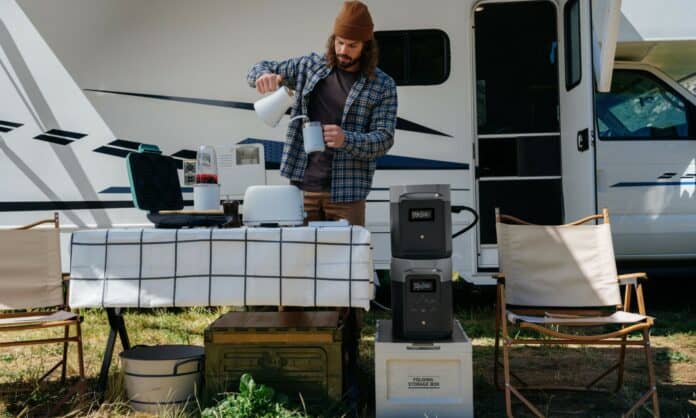Table of Contents
Dual battery systems are vital for ensuring continuous vehicle power, as they support auxiliary functions without draining the main battery. Today, we’ll examine dual setups’ mechanics, benefits, and implementation challenges, providing insights into selecting, installing, and maintaining these systems for optimal performance and longevity.
While focusing on dual solutions, we’ll also discuss promising alternatives positioned as superior options for many users, helping you decide the optimal choice for your needs. Let’s dive into an insightful exploration of your options, arming yourself with the knowledge to enhance your power solutions.
What Is a Dual Battery System?
A dual battery system, often a staple in off-road vehicles, caravans, and boats, involves installing two separate batteries within a vehicle. This setup ensures that one battery (the starter) is dedicated solely to starting the engine and running the vehicle’s primary electrical systems; the second (the auxiliary battery) powers additional accessories like fridges, lighting, and entertainment systems.
The key benefit of this configuration is that it allows the auxiliary battery to be used without the risk of draining the main, ensuring that the vehicle will always start. This setup often includes a battery isolator or a dual battery controller to manage the charging process and prevent the auxiliary battery from sapping power from the starter battery.
Why Would I Need a Dual Battery System?
The necessity of a dual battery system arises when you require consistent and reliable power for accessories without compromising the vehicle’s ability to start. If you’re an avid camper or overlander, or you use your vehicle for work where power tools and other equipment are essential, a dual system offers the peace of mind that you won’t be stranded with a dead starter battery.
Moreover, a dual setup is invaluable for those who enjoy remote travels or need to operate equipment like winches, lights, or communication devices independently of the vehicle’s primary electrical system. It ensures that your vehicle’s essential functions remain unaffected by the additional power demands, providing a stable and dedicated power source for all your auxiliary needs.
How Do Dual Battery Systems Work?
Dual battery systems work through separation and specialisation: one battery (the starter battery) is designated for starting the vehicle and running its primary systems, while the other (the auxiliary battery) is used for additional power needs. This separation is crucial to ensure that accessories and secondary devices don’t impact the vehicle’s ability to start.
The system is equipped with an isolator or a dual controller, which is pivotal in managing the charging and power distribution between the two batteries. When the vehicle’s engine runs, the isolator allows both batteries to charge simultaneously without drawing power from each other. Once the engine is off, the isolator separates the two batteries, ensuring that only the auxiliary battery is used to power additional accessories, thereby protecting the starting battery’s charge.
Some advanced dual systems include a solenoid or DC-DC charger, which not only isolates but also manages the charging voltage and current to optimise a battery’s life and performance. The DC-DC charger is particularly beneficial when dealing with different types of batteries (e.g., AGM, lithium-ion, etc.) as it can adjust the charging profile to suit each type, ensuring they’re charged safely and efficiently.
This setup provides a reliable power source for accessories like camping fridges, lighting, and electronic devices, ensuring they can run for extended periods without risking the vehicle’s startup capability. The system’s design ensures users can enjoy modern conveniences remotely without draining the vehicle’s starting capabilities.
The Pros and Cons of Dual Battery Setups
Implementing a dual battery system can significantly enhance your power management capabilities, especially if you’re an enthusiast of off-grid adventures or require reliable auxiliary power for work-related purposes. Understanding the advantages and disadvantages of this system is crucial to determining whether it’s the right solution for your needs. Here, we’ll delve into the pros and cons to provide a balanced perspective on dual battery setups.
Pros
Enhanced Power Capacity and Reliability
A dual-battery system effectively doubles your power capacity, providing a dedicated source for auxiliary uses without compromising the main battery’s role in starting the vehicle. This setup offers the reliability needed for extended trips or work scenarios where consistent power is essential, ensuring that accessories and tools can operate independently of the vehicle’s primary electrical functions.
Isolation Protects Primary Battery
The system’s design protects the starter battery from being drained by auxiliary power demands. With a dedicated auxiliary battery, users can operate additional equipment and accessories, knowing the vehicle’s starting power remains intact. This isolation feature is particularly valuable in remote locations where a reliable start is paramount.
Customisable Power Solutions
Dual battery systems offer the flexibility to scale your power setup to your specific needs. Whether adding capacity for heavy-duty tools, enhancing comfort with entertainment systems, or ensuring critical navigation and communication devices remain powered, the system can be customised to suit various applications and requirements.
Improved Power Management
With the addition of smart isolators or DC-DC chargers, dual battery systems provide additional power and improve their overall management. These devices ensure optimal charging and power distribution, extending the lifespan of your batteries and ensuring they perform efficiently during their service life.
Cons
Complexity of Installation
Installing a dual battery system can be complex and often requires professional assistance, particularly for those without electrical expertise. Integrating the system into the vehicle’s existing electrical setup can be time-consuming and may require a thorough understanding of automotive electrical systems. A more user-friendly solution like a solar generator could offer significant advantages, including ease of installation, maintenance, and overall user experience.
Increased Weight and Space Requirements
Adding an extra battery and associated components increases your vehicle’s weight, which could impact fuel efficiency and handling. Additionally, the space required for a second battery may limit storage capacity or require modifications to accommodate the setup.
Maintenance and Monitoring
While dual systems are designed to be robust, they do require regular maintenance and monitoring to ensure optimal performance. This includes checking connections, monitoring charge levels, and ensuring that both batteries function correctly, which can add another layer of routine checks for the vehicle owner.
Upfront and Ongoing Costs
The initial investment for a dual battery system, including the cost of the batteries, isolator, wiring, and installation, can be significant. Additionally, the potential need for replacement parts or upgrades over time adds to the overall cost of ownership.
Technical Knowledge Required for Troubleshooting
If issues arise with your system, diagnosing and resolving them can require a substantial level of technical knowledge. This might pose a challenge for those not versed in automotive electrical systems, leading to potential downtime or the need for professional assistance.
Using a Solar Generator as an Alternative to a Dual Battery System
While dual battery systems have several key advantages, solar generators present a compelling alternative, offering a blend of convenience, efficiency, and simplicity. Let’s explore the benefits of opting for a solar generator over a traditional dual-battery setup.
What Are the Benefits?
Ease of Installation
One of the standout benefits of a solar generator is its ease of installation and use. Unlike a dual battery system, which requires complex wiring and integration into a vehicle’s electrical system, a solar generator is a standalone unit. There’s no need to worry about selecting the right type or the intricacies of wiring it directly into the vehicle. Simply set up the solar generator and plug it into your devices or appliances.
Portable and Versatile
Solar generators are inherently portable, allowing you to use them across various settings as well as your vehicle. Whether camping, at a remote job site, or expecting a power outage at home, a solar generator can easily be relocated and utilised wherever you need power most.
Renewable Energy Source
Solar generators provide an environmentally friendly power solution by harnessing solar power. This renewable energy source reduces reliance on fossil fuels and minimises your carbon footprint, aligning with a growing preference for sustainable, eco-conscious choices.
Low Maintenance
Compared to dual battery systems, solar generators require minimal maintenance. With no moving parts and simple electronic components, the need for regular checks and maintenance is significantly reduced, offering a hassle-free power solution.
Scalability
Solar generators offer the flexibility to scale up your power system as needed. You can easily add more solar panels or link multiple generators to increase power output, providing a customisable solution that grows with your energy demands.
Choosing a solar generator like EcoFlow’s offers a user-friendly, sustainable, and versatile power solution that can easily adapt to various environments and needs, making it an attractive alternative to traditional dual systems.
Frequently Asked Questions
Whether you need a dual battery system depends on your power usage. If you often use your vehicle for activities requiring additional power—like camping, using power tools, or running heavy electronics—a dual battery system can ensure you have power without straining your main battery.
The lifespan of a dual setup varies based on usage, maintenance, and battery type. Generally, an auxiliary battery in a well-maintained dual system can last about 3 to 5 years. Regular monitoring and proper charging practices are crucial to maximising its lifespan.
You don’t necessarily need a bigger alternator for two batteries. Most standard alternators can handle the extra load of a second battery. However, if your power demands are high or if you frequently drain the auxiliary battery, upgrading to a higher-capacity alternator can ensure both batteries charge efficiently and maintain optimal performance.
Final Thoughts
Dual battery systems offer a robust solution for those requiring reliable auxiliary power, ensuring power shortages don’t hinder your adventures or work. These systems provide a dedicated energy source, allowing for the use of various accessories and tools without impacting the vehicle’s main battery.
However, considering the complexities of installation and maintenance, it’s also worth exploring alternative solutions. For a more straightforward yet equally effective power solution, consider solar generators offering ease of use, sustainability, and versatility. Explore how EcoFlow Solar Generators can meet your power needs and discover more about how we can be your partner for a renewable energy future.


